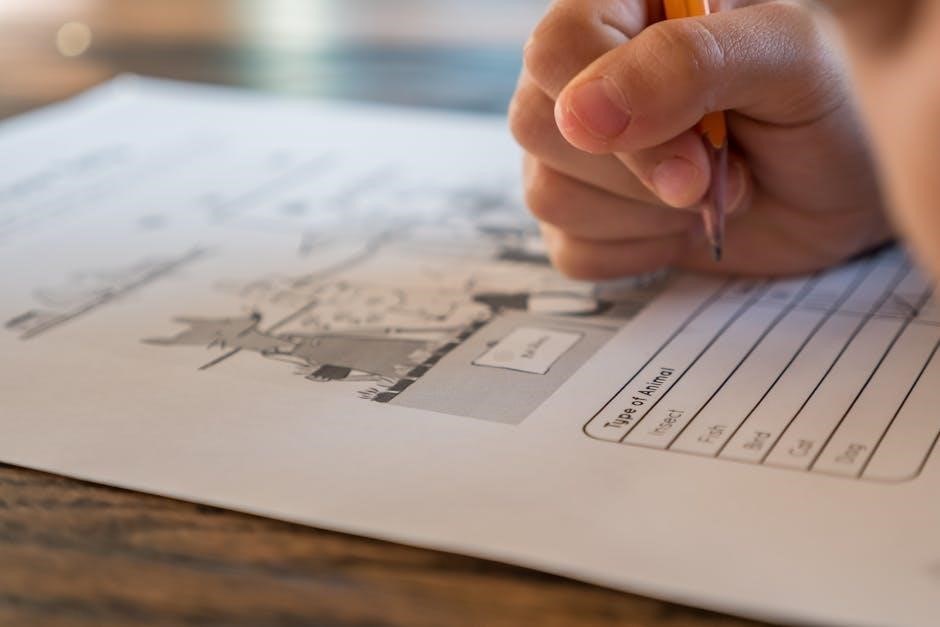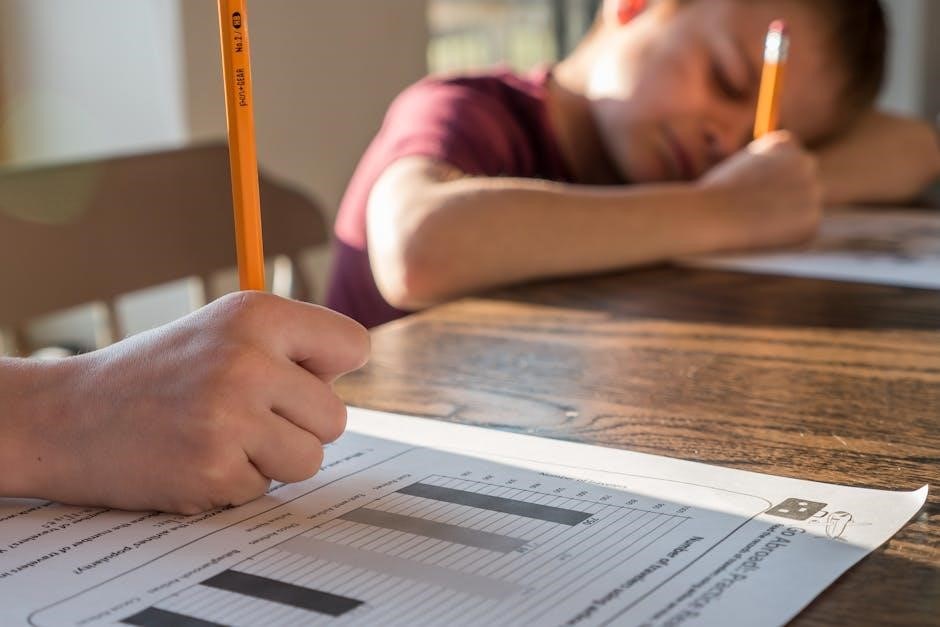Becoming a firefighter requires passing a demanding written test․ This guide provides essential strategies and resources to help candidates excel, covering key areas like mechanical aptitude, problem-solving, and situational judgment․
Importance of the Firefighter Written Test
The firefighter written test is a critical step in the hiring process, assessing aptitude, problem-solving, and decision-making skills․ It evaluates a candidate’s ability to handle firefighting scenarios, mechanical systems, and emergency protocols․ High scores are essential for advancing in the selection process, as competition is fierce․ The test reflects real-life challenges firefighters face, ensuring only the most capable individuals succeed․ By measuring skills like reading comprehension, situational judgment, and mathematical reasoning, it identifies those with the potential to excel in this demanding role․ Performing well demonstrates a candidate’s readiness to handle the physical and mental demands of firefighting, making it a cornerstone of the selection process․
Overview of the Study Guide
This comprehensive firefighter written test study guide is designed to equip candidates with the tools and knowledge needed to excel on the exam․ It covers essential topics such as mechanical reasoning, reading comprehension, and situational judgment, providing detailed explanations and practice questions․ The guide includes sample test questions from various fire departments, like the CWH Next Generation Entry-Level Firefighter/EMT Aptitude Test and the Firefighter Aptitude and Character Test (FACT)․ It also offers strategies for time management and effective test-taking techniques․ By focusing on real-life scenarios and critical thinking exercises, the guide helps candidates build confidence and readiness for the challenges of the firefighter written exam․

Understanding the Firefighter Written Test Format
The firefighter written test assesses mechanical reasoning, reading comprehension, and situational judgment․ It includes multiple-choice questions and scenario-based problems, requiring strong analytical and decision-making skills․
Types of Questions and Sections
The firefighter written test includes multiple-choice questions, scenario-based problems, and reading comprehension passages․ Sections cover mechanical reasoning, mathematics, and situational judgment․ Mechanical reasoning tests understanding of levers, gears, and pulleys․ Mathematics involves basic arithmetic and word problems related to firefighting scenarios․ Reading comprehension requires interpreting passages on fire safety and emergency procedures․ Situational judgment presents ethical dilemmas and safety protocols, assessing decision-making skills․ Each section evaluates different aptitudes essential for firefighting, ensuring candidates possess both technical knowledge and practical problem-solving abilities․ Understanding these question types helps focus study efforts, improving overall performance and readiness for the exam․
Time Management and Question Allocation
Effective time management is crucial for success on the firefighter written test․ Allocate time wisely by skimming through the entire exam first to identify easier questions․ Set a timer for each section, ensuring you spend no more than 1-2 minutes per question․ Prioritize questions you’re confident about to secure early points․ For complex sections like mechanical reasoning, allocate extra time to avoid rushing․ Avoid lingering on difficult questions—flag them and return later․ This strategy maximizes the number of attempts and reduces anxiety․ Practice pacing during study sessions to build stamina and efficiency․ Proper time allocation ensures you complete the test calmly, improving accuracy and overall performance․
Scoring System and Passing Requirements
The firefighter written test uses a scoring system where each correct answer earns points, with no deduction for incorrect responses․ The passing score is typically 70%, but this can vary by department․ High scorers are prioritized for advancement․ Some tests include sectional scoring, requiring minimum thresholds in areas like mechanical reasoning or situational judgment․ Competitive departments may require scores above 80% to progress․ Final scores are often normalized to ensure fairness across test administrations․ Candidates must meet or exceed the passing score to qualify for the next stages, such as physical exams or interviews․ Understanding the scoring system helps candidates focus their study efforts effectively․ Aim for accuracy and completeness to achieve a competitive score․

Key Subject Areas Covered in the Test
The firefighter written test evaluates mechanical reasoning, reading comprehension, mathematics, situational judgment, and firefighter-specific knowledge․ These areas assess problem-solving, comprehension, and decision-making skills critical for the role․
Mechanical Reasoning and Aptitude
Mechanical reasoning tests your ability to understand and apply principles of mechanics to solve problems․ Topics include levers, gears, pulleys, and hydraulic systems․ Questions often involve calculating forces, motion, and energy transfer․ Firefighters must grasp these concepts to operate equipment and handle emergencies effectively․ Practice with diagrams and real-world scenarios will improve your understanding․ Focus on recognizing relationships between components and their functions․ This section assesses your problem-solving skills under time constraints, simulating the pressures of real firefighting situations․ Accurate visualization and logical thinking are key to success․ Regular practice with sample questions will enhance your aptitude and confidence in tackling mechanical problems efficiently․
Reading Comprehension and Vocabulary
Reading comprehension and vocabulary are critical for understanding complex texts and firefighting scenarios․ This section tests your ability to interpret passages, identify main ideas, and comprehend technical terminology․ Questions may involve analyzing safety protocols, equipment descriptions, or emergency procedures․ To excel, practice skimming and identifying key details quickly․ Expand your vocabulary by studying firefighting-related terms and their definitions․ Focus on context clues to deduce unfamiliar words․ Regular reading of firefighting manuals and practice passages will improve your speed and accuracy․ Strong comprehension skills are essential for making quick, informed decisions in high-pressure situations․ Effective vocabulary knowledge ensures clear communication and understanding of critical information during operations․
Mathematics and Problem-Solving
Mathematics and problem-solving are essential for firefighters, as they often involve calculating distances, estimating water pressure, or determining resource allocation․ This section assesses your ability to solve basic arithmetic operations, interpret graphs, and apply mathematical concepts to real-world scenarios․ Focus on practicing fractions, decimals, and algebraic equations․ Problem-solving questions may present emergency situations requiring quick, logical decisions․ Review formulas for area, volume, and flow rates, as these are commonly tested․ Use practice tests to identify weak areas and improve your mental math skills․ Accurate and efficient problem-solving is critical for making life-saving decisions in the field․ Regular practice ensures confidence and precision during the exam․
Situational Judgment and Decision-Making
Situational judgment and decision-making assess your ability to handle real-life emergency scenarios․ Questions present hypothetical situations, asking how you would respond․ This tests your problem-solving, ethical reasoning, and understanding of safety protocols․ Focus on prioritizing tasks, ensuring safety, and making quick decisions․ Practice analyzing scenarios like rescuing trapped individuals or managing limited resources․ Review past exam questions to understand the format․ Familiarize yourself with firefighter protocols and ethical guidelines․ Time management is key, as decisions must be made under pressure․ Use study materials to refine your critical thinking skills․ Accurate and ethical decision-making is vital for this role․ Regular practice enhances your ability to perform effectively in high-stress situations․
Firefighter-specific Knowledge and Scenarios
This section evaluates your understanding of firefighting procedures, equipment, and emergency response protocols․ Questions cover fire behavior, hazardous materials, rescue techniques, and communication methods․ Familiarize yourself with standard operating procedures and safety guidelines․ Practice scenarios involving vehicle extrication, fire suppression, and medical emergencies․ Review equipment usage, such as hoses, ladders, and breathing apparatus․ Understand fire codes and safety regulations․ Study real-life case studies to improve decision-making․ Use official firefighter manuals and training materials for accurate preparation․ Regularly test your knowledge with practice exams to ensure mastery of these critical areas․ This section is essential for demonstrating your readiness to perform as a firefighter in real-world situations․

Study Strategies for Success
Set clear goals, prioritize weak areas, and allocate time wisely․ Use active learning techniques, practice consistently, and review mistakes․ Join groups for collaborative learning and stay motivated by tracking progress․
Creating a Study Schedule
A well-structured study schedule is crucial for success․ Start by setting clear, achievable goals and break them into manageable daily tasks․ Allocate specific time slots for each subject area, ensuring a balance between different sections of the test; Prioritize your weakest areas and dedicate extra time to improving them․ Use a calendar or planner to track your progress and stay organized․ Consistency is key, so commit to regular study sessions even on weekends․ Incorporate short breaks to maintain focus and avoid burnout․ Regularly review and adjust your schedule to ensure it remains effective and aligned with your progress․ Stick to your plan diligently to build confidence and readiness․
Effective Note-Taking Techniques
Effective note-taking is essential for retaining information while studying for the firefighter written test․ Use the Cornell Method: divide paper into sections for notes, summaries, and keywords․ Outline key concepts to organize information hierarchically․ Practice mind mapping to visually connect ideas․ Use symbols and abbreviations to save time․ Review notes within 24 hours and summarize them in your own words․ Focus on active recall by quizzing yourself using your notes․ Highlight and underline important points for quick reference․ Stay consistent with your method to ensure clarity and ease of review․ Tailor your technique to your learning style for maximum retention and test performance success․
Utilizing Online Resources and Practice Tests
Online resources and practice tests are invaluable tools for preparing for the firefighter written test․ Websites like FirefighterExam․com and FireServiceIQ․com offer comprehensive study materials, including practice questions and mock exams․ Utilize these platforms to familiarize yourself with the test format and content․ Many resources provide detailed explanations for correct and incorrect answers, helping you understand your mistakes․ Regularly taking practice tests can improve your speed, accuracy, and confidence․ Additionally, online forums and communities allow you to connect with other candidates, share strategies, and gain insights․ Prioritize resources that align with your specific exam requirements and focus on consistent practice to achieve optimal results and readiness for test day․
Joining Study Groups or Forums
Joining study groups or forums can be a highly effective way to prepare for the firefighter written test․ These communities provide a platform to collaborate with others who are also preparing for the exam․ By sharing insights, discussing challenging topics, and learning from one another, you can gain a deeper understanding of the material․ Additionally, study groups help keep you motivated and accountable․ Many forums and groups are available online, such as Reddit’s firefighter preparation communities or specialized Facebook groups․ Active participation in these spaces can also help you identify areas where you need improvement and provide access to shared resources like study guides and practice questions․ Engaging with others can make your study process more dynamic and productive․

Staying Motivated and Focused
Staying motivated and focused is crucial when preparing for the firefighter written test․ Set clear, achievable goals to track your progress and maintain momentum․ Celebrate small victories, like mastering a difficult topic, to stay encouraged․ Surround yourself with supportive individuals who understand your dedication․ A positive mindset and consistent effort are key to overcoming challenges․ Incorporate physical activity into your routine to reduce stress and improve concentration․ Remind yourself of your ultimate goal—becoming a firefighter—to reignite motivation when it wanes․ Stay disciplined, and avoid procrastination by breaking study sessions into manageable parts․ By staying committed and focused, you’ll build the mental resilience needed to excel on test day and beyond․

Practice Tests and Mock Exams
Practice tests and mock exams are essential for assessing strengths, identifying weaknesses, and improving time management․ They simulate real test conditions, building confidence and readiness․
Locating Reliable Practice Tests
Locating reliable practice tests is crucial for effective preparation․ Official fire department websites and firefighter training organizations often provide authentic practice materials․ Commercial test prep companies specialize in creating firefighter exam-specific practice tests․ Additionally, study guides and books, such as the NFPA Handbook or Firefighter Exam books, include practice questions․ Online forums and communities, like Reddit’s r/Firefighter or specialized Facebook groups, share user-generated practice tests․ Ensure the tests are recent, relevant, and cover all sections of the exam․ Look for materials that include answer explanations to improve understanding․ Combining official and third-party resources ensures a well-rounded practice experience․
Simulating Test Conditions
Simulating test conditions is essential for building exam readiness․ Create a quiet, distraction-free environment that mirrors the actual test setting․ Use a timer to adhere to the exam’s time limits, ensuring you practice under pressure․ Dress in attire similar to what you’ll wear on test day to acclimate to the feel․ Mimic the test format by using practice tests that match the question types and structures․ Consider having someone proctor the session to add realism․ This simulation helps you mentally prepare for the exam atmosphere, reducing anxiety and improving focus․ Regularly practicing under these conditions enhances your ability to manage time and stay calm during the actual test․ Consistency is key to achieving peak performance․
Reviewing and Learning from Mistakes
Reviewing and learning from mistakes is a critical step in improving performance on the firefighter written test․ After completing practice tests, thoroughly analyze incorrect answers to identify patterns or weaknesses․ Understand the reasoning behind correct responses and address gaps in knowledge․ Maintain a log of errors to track progress and refine study strategies․ Focus on understanding concepts rather than just memorizing facts․ Learning from mistakes builds resilience and enhances problem-solving skills․ Regular review helps reinforce learning and reduces the likelihood of repeating errors․ This process ensures continuous improvement and boosts confidence for the actual exam․ Consistent effort in this area is vital for achieving a high score․
Timing and Pacing Strategies
Mastering timing and pacing is essential for success on the firefighter written test․ Calculate the average time per question by dividing the total exam duration by the number of questions․ Allocate time evenly across sections, prioritizing challenging areas․ Practice under timed conditions to build stamina and accuracy․ Avoid spending too long on a single question—use elimination techniques to make educated guesses․ Skip difficult questions initially and return to them later․ Keep a steady pace to avoid rushing near the end․ Consistent practice with timed drills improves speed and confidence, ensuring you complete the test within the allotted time․ Proper pacing reduces anxiety and enhances performance․
Building Confidence Through Practice
Building confidence through practice is a cornerstone of success on the firefighter written test․ Regular practice helps familiarize you with the test format, question types, and content․ Consistent exposure to practice tests reduces anxiety and builds familiarity, making the actual test feel more manageable․ As you improve your scores and understanding, your self-assurance grows, enabling you to approach the exam with a positive mindset․ Practice also highlights strengths and areas needing attention, allowing targeted improvement․ By mastering test-taking strategies and reinforcing knowledge, you develop the confidence to tackle challenging questions and perform at your best․ Regular practice fosters resilience and mental preparedness, essential for achieving success․

Specific Tips for Each Section
Understand question types to target your study efforts․ Focus on mechanical reasoning, reading comprehension, and math․ Practice situational judgment and firefighter-specific scenarios․ Stay calm and manage time effectively․
Mechanical Reasoning: Levers, Gears, and Pulleys
Mechanical reasoning assesses your understanding of basic mechanical principles․ Focus on levers, gears, and pulleys, which are common in firefighting equipment․ Practice calculating torque, force, and motion․ Understand how gears interact and ratios affect speed and effort․ For pulleys, learn to determine mechanical advantage and lifting force required․ Visualize mechanisms to solve problems efficiently․ Review physics basics and firefighter tools that rely on these systems․ Regular practice with diagrams and formulas will improve your ability to analyze and solve mechanical scenarios quickly and accurately․ Relate concepts to real-world firefighting applications to build a stronger foundation and enhance problem-solving skills․

Reading Comprehension: Speed Reading and Retention
Mastering reading comprehension is crucial for the firefighter written test․ Focus on improving speed while maintaining understanding․ Practice active reading techniques, such as skimming headings and identifying key points․ Develop the ability to retain information by summarizing paragraphs in your own words․ Use context clues to infer meanings of unfamiliar words․ Train yourself to read in chunks rather than word by word to boost speed․ Regularly practice with sample passages and timed drills to enhance efficiency․ Strengthen retention by highlighting and reviewing critical details․ These strategies will help you quickly grasp complex texts, ensuring accurate answers under time pressure․ Consistent practice will refine your skills, making you more confident and efficient during the test․
Mathematics: Basic Arithmetic and Word Problems
Mathematics is a fundamental section of the firefighter written test, focusing on basic arithmetic and practical word problems; Emphasize mastering operations like addition, subtraction, multiplication, and division, as well as fractions, decimals, and percentages․ Practice solving word problems related to firefighting scenarios, such as calculating water flow rates, estimating distances, or determining resource allocation․ Improve your ability to interpret numerical data quickly and accurately․ Use mental math techniques to save time and reduce errors․ Regularly solve practice problems to build speed and confidence․ Familiarize yourself with formulas and shortcuts for common calculations․ Strong math skills are essential for success in this section and real-world firefighting applications․ Stay focused and precise to achieve high scores․
Situational Judgment: Ethical and Safety Scenarios
The situational judgment section assesses your ability to make ethical and safe decisions in firefighting scenarios․ Questions present real-life situations, asking how you would respond․ Focus on prioritizing safety, adhering to protocols, and demonstrating ethical judgment․ Practice analyzing scenarios involving emergency responses, teamwork, and conflict resolution․ Consider the consequences of actions and choose the most appropriate solution․ Review firefighter codes of conduct and safety guidelines to inform your decisions․ Simulate decision-making under pressure to improve your critical thinking skills․ This section evaluates your readiness to handle the moral and practical challenges of firefighting․ Stay calm, think clearly, and always prioritize safety and ethical behavior․
Firefighter-specific: Emergency Procedures and Protocols
This section tests your knowledge of standard emergency procedures and firefighting protocols․ Focus on understanding common scenarios, such as fire suppression, rescue operations, and medical emergencies․ Familiarize yourself with protocols like RIC (Rapid Intervention Crew) procedures, Mayday calls, and incident command systems․ Study the proper use of firefighting tools and equipment, such as hoses, ladders, and thermal imaging cameras․ Review communication methods and teamwork principles during emergencies․ Practice scenarios involving hazardous materials, structural fires, and vehicle extrications․ Understand safety protocols, including the PASS system (Pull the pin, Aim, Squeeze, Sweep) for SCBA use․ Stay updated on NFPA standards and local fire department guidelines to ensure accurate responses․

Test Day Preparation
Ensure physical and mental readiness by getting adequate rest․ Arrive early, bringing required documents and writing materials․ Stay calm, avoid last-minute cramming, and stay focused․
Physical and Mental Readiness
Physical and mental readiness is crucial for peak performance on test day․ Ensure adequate rest and a balanced diet in the days leading up to the exam․ Engage in light exercise to maintain energy and reduce stress․ Avoid heavy meals and caffeine on test morning to prevent fatigue or anxiety․ Mentally prepare by practicing relaxation techniques, such as deep breathing or meditation, to stay calm and focused․ A clear mind and healthy body will enhance concentration and problem-solving abilities, helping you approach the test with confidence and clarity․ Prioritize self-care to optimize your mental sharpness and physical stamina for the challenge ahead․
What to Bring to the Test Center
Ensure you arrive prepared by bringing essential items to the test center․ A valid government-issued ID, such as a driver’s license or passport, is required for verification․ Bring your admission letter or confirmation email, either printed or digitally accessible․ Pack pens, pencils, and a calculator if permitted by the test center’s rules․ A small notebook for rough calculations can also be useful․ Wear comfortable clothing and stay hydrated by bringing a water bottle․ Avoid bringing prohibited items like phones, watches, or bulky bags․ Check the test center’s specific rules beforehand to avoid issues․ Organize your items in a clear bag or small backpack for easy access․ Being well-prepared eliminates distractions and helps you focus on performing your best․
Last-Minute Tips and Reminders
Stay calm and focused on test day by arriving early to the center․ Plan your route in advance to avoid delays․ Eat a nutritious meal and get plenty of rest the night before to ensure mental clarity․ Avoid cramming last-minute information, as it can increase stress․ Skim through your notes briefly to reinforce key concepts․ During the test, read each question carefully and eliminate incorrect answers before selecting your response․ Manage your time wisely, allocating a few minutes to review unanswered questions․ Stay hydrated and take deep breaths to maintain composure․ Confidence and a positive mindset are key to performing your best․ Remember, preparation is your greatest asset—trust in your hard work․

Post-Test Actions
After completing the test, await official results and feedback․ Understand the scoring criteria and next steps in the hiring process․ Stay informed through official channels․
Interpreting Results and Feedback
After receiving your test results, carefully review the score breakdown to identify strengths and areas for improvement․ Understand the scoring scale and passing threshold․ Pay attention to feedback provided, as it highlights specific questions or sections where you may need additional study․ Analyze patterns in incorrect answers to pinpoint weaknesses in knowledge or reasoning skills․ Use this information to refine your study plan for future exams or retakes․ Keep track of progress over time to gauge improvement․ If scores are borderline, consider retesting or seeking additional resources to address gaps․ Accurate interpretation of results is crucial for effective preparation and long-term success in the firefighter hiring process․
Next Steps After Passing the Test
After passing the firefighter written test, focus on preparing for the next stages of the hiring process․ Prioritize training for the physical ability test, such as the CPAT, using fitness guides and practice sessions․ Research and prepare for oral interviews by reviewing common questions and practicing responses․ Additionally, gather required documents, such as medical clearance and certifications, to ensure eligibility․ Stay updated on the hiring process timeline and any additional assessments, like psychological evaluations․ Network with current firefighters for insights and advice․ Continue refining skills and knowledge to excel in subsequent evaluations․ Maintaining physical fitness and mental preparedness will be crucial as you progress toward becoming a firefighter․
Preparing for the Physical Exam and Interviews
After passing the written test, focus on preparing for the physical exam and interviews․ The physical exam, such as the CPAT, requires building endurance, strength, and agility․ Create a workout plan targeting core muscles, cardiovascular fitness, and simulation of firefighting tasks․ For interviews, research common questions and practice articulating your skills, experiences, and motivations․ Mock interviews with mentors or study groups can improve confidence and articulation․ Additionally, familiarize yourself with the fire department’s values and mission to align your responses․ Lastly, ensure your appearance is professional and arrive early for the interview․ Demonstrating both physical and verbal readiness will enhance your chances of advancing in the hiring process․
